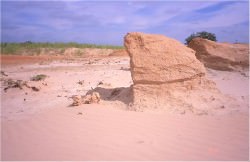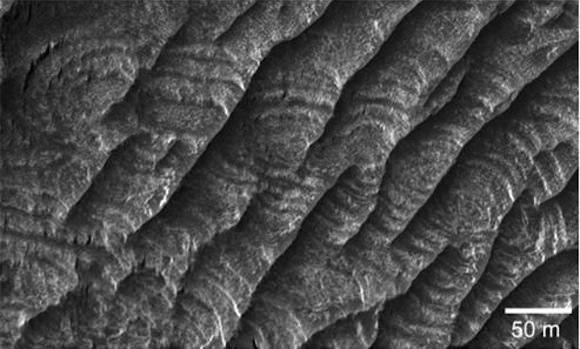[/caption]
Geologists are often surprised to find features on Earth replicated on other worlds; ancient riverbeds on Mars, lakes on Titan, and volcanic eruptions on Io. But researchers from the University of Washington have identified a geologic feature that exists on Mars…
But not on Earth.
These structures are known as periodic bedrock ridges. They look like sand dunes on the surface of Mars, but instead of sand piled high by strong winds, it appears that the wind has carved dune-like ridges right into the Martian bedrock.
“These bedforms look for all the world like sand dunes but they are carved into hard rock by wind,” said David Montgomery, a UW professor of Earth and space sciences. It is something there are not many analogs for on Earth.”

What could create such a unique feature? According to Prof. Montgomery, the ridges are probably a softer form of bedrock, which is easier for the Martian wind to erode it away. One similar feature on Earth is known as a “yardang”, but these are teardrop-shaped features parallel to the direction of the wind.
But on Mars, these periodic bedrock ridges are perpendicular to the flow of the prevailing wind, just how sand dunes form on Earth (and Mars).
The additional ingredient in the weather on Mars is probably some kind of deflection. The high speed surface winds are deflected up into the air by a land formation, and then they come down to the surface and create these periodic ridges. The length of the gap in the ridges depends on the strength of the wind, size of the deflection and the density of the atmosphere.
Apart from the fact that this is just really cool, there’s a scientific benefit too. This wind will expose layers of rock, created eons ago. A rover could travel across these ridges, sampling very different ages of Martian geology in a local area.
It would be an all-you-can-eat Martian geology buffet.
Original Source: University of Washington News Release


That geological formation looks baffling… then I realised the light was coming from the left. Doh!
It kind of looks like water rippling on the surface of a river over a rocky bottom.
Or a strip mine that’s been sectioned off for all interested parties.
Brain surface… I see grey matter.
Yardang is a great scrabble word!
Dang, yer right!
Can they be seen through a telescope?
nope. not even close.
Well, MRO is quite close, and its camera includes a telescope…
NO. Even Hubble Space Telescope can’t see it.
yeah, we do need an indicator for light direction. To me, it was big rolling humps until I reversed it just to see what it might be. I don’t see any earthly rovers able to “travel across these ridges”. But maybe you should design something like our original invaders from the red planet a la H.G. Wells, Fraser. The wind must contain sand, right. Wind alone can’t carve rock…notice the pictured yardang is on a beach. Good scouring action in sand. Interesting pic!
It depends on the size and scale, I suppose. I’m imagining smooth expanses of exposed rock with ripples, but maybe we’ve just got to send humans.
We don’t know the vertical scale, which can be emphasized (and often is AFAIK).
Does this imply that the wind has been blowing the same speed and direction for millions of years?
If parallel cracks occur deep in layered soft bedrock, due to some tectonic activity, and if these cracks get filled up by harder minerals, due to a longer process of hydrothermal activities, and if later tectonic activities lift the bedrock high enough that its surface will be eroded, until erosion gnawns the bedrock down to the layers which contain the mineralized cracks, then the mineralized cracks will resist erosion better than the softer bedrock, and stand out, and you get the result seen on the picture above.
Some years ago, there were photos from the MRO Hirise camera published, showing other regions on Mars where mineral veins in the martian soil had a similar effect.
Resemles pahoehoe lava but is not?
Are there any 3D images of these periodic bedrock ridges?
This does look like a boundary layer effect. The motion of a gas across a surface can result in this sort of warping of the surface. The washer board surface of unpaved roads is an analogue of this. The formation of water waves by wind is another clear case as well. The 25 to 50 meter wavelength of these ridges reflects the low energy of wind across the surface. The thin Martian atmosphere does not have much kinetic energy density ? = (1/2)?v^2, for ? the density of gas moving at velocity v. The energy of atmospheric gas flow through a volume V is K = ?V.
The ridges do appear somewhat “ropy,” where this might be due to the angle of sight this image was taken. If this is really as ropy as it looks that is unexpected, for a cusp at the bottom of these ridges is hard to explain.
LC